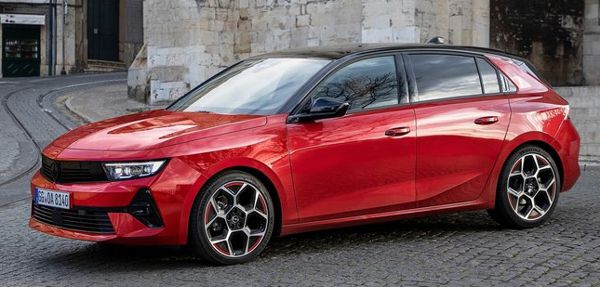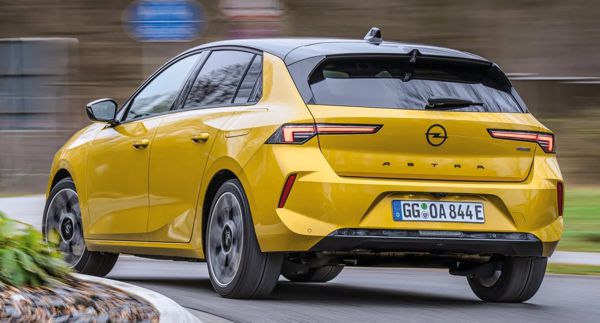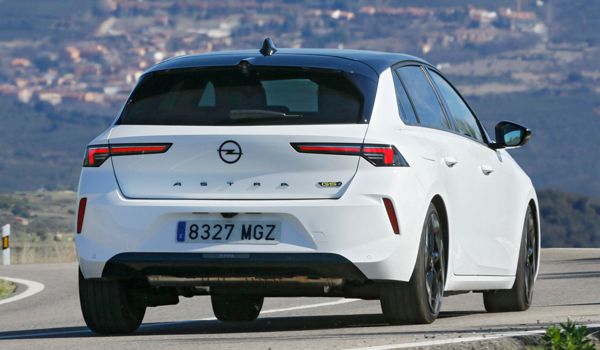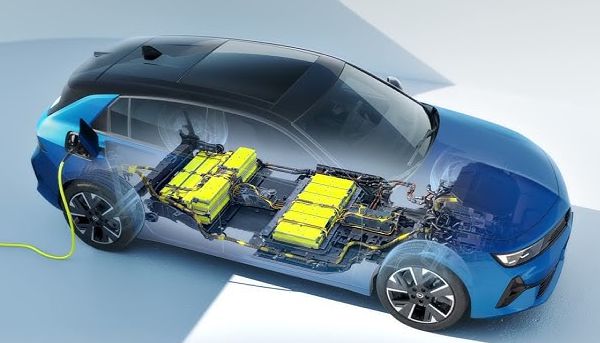Published
on 10
Oct 2022
|
All rights reserved.
|
|
|

|
|
New
Astra marks a new chapter of Opel's family hatch, now built under the
umbrella of Stellantis for the first time.
|
|
Opel/Vauxhall Astra used
to be a strong-selling family hatch in Europe – and once worldwide,
too. However, its fortune seems to be declining in the last couple of
decades. The last generation Astra got lighter, sportier and more fuel
efficient, but generally failed to match the best of the class in terms
of design, build quality and refinement, i.e. areas that customers
really care about. It was also stripped of interesting variants such as
OPC, GTC and cabriolet, leaving only cooking models to give a boring
impression. Prospect looked pessimistic until Stellantis group took
over the firm from General Motors in 2017. In the safe hands of new
owner, Opel/Vauxhall not only loses no factories but it is also
benefited from the arsenal of Stellantis, i.e. the simple but
up-to-date and very mass selling platforms. This makes it possible to
develop new cars quickly and build them more cost effectively, although
inevitably losing some of its own characters.
Speaking about characters, Opel/Vauxhall has never owned a strong
character that buyers truly adore, so the transition to Stellantis
platforms seem to have nothing to lose.
The new Astra is built on Stellantis’ EMP2 platform, which underpins
also Peugeot 308 and the group’s larger cars. Its “hardpoints” seem to
be very hard indeed, as evident in a body profile very close to the
Peugeot. Instead of the old car’s sweeping front end, the new one has a
conventional 2-box body, with a flat bonnet, more upright windscreen
and tailgate, just like the 308. However, the combination of broader
shoulders and detailed design makes it actually more stylish, if not as
stylish as Peugeot. The new body is also quite efficient in
aerodynamics, returning a drag coefficient of 0.27, and enjoy a
14-percent boost in torsional rigidity.

|
|
Shares
virtually the same profile with Peugeot 308, as is the platform
underneath.
|
|
Inside is where it differs from 308 the most. While the Peugeot employs
love-it-or-hate-it i-Cockpit which positioned the instrument above
steering wheel, the Opel uses a more conventional instrument layout
that is proved to be more ergonomical to most drivers. The standard of
build quality and material richness are definitely lower than that of
Peugeot, but no worse than the downgraded VW Golf Mk8. At least the
plastics and switchgears feel sturdy, something not always true in its
predecessors. To my eyes, the least satisfying is the piano-black panel
that does a poor job to pretend to be a wide screen. A 10-inch
instrument screen is recessed uglily there, while another 10-inch
touchscreen doesn’t fit into the panel very well either. The digital
instrument is configurable but none of the graphics look attractive.
The infotainment system is not the sleekest to operate, but far less
annoying than the Golf. Moreover, Stellantis insists to leave physical
switches for operating climate control, so you don’t need to get deep
into the touchscreen menus to adjust air-con temperature.
The new Astra has virtually the same footprint as the old car, but it
is 44mm lower. The cabin is not terribly spacious. While front
occupants enjoy plenty of room, rear passengers will find leg and
headroom tighter than arch-rivals like Golf and Ford Focus, a weakness
shared by its Peugeot cousin. This is partly because EMP2 is designed
to accommodate PHEV powertrain, thus it leaves more space behind the
rear seats to accommodate a 12.4kWh battery pack. On combustion engine
models, without the battery they are able to offer remarkable luggage
space of 422 liters, compared with 375 liters on Ford and 381 liters on
VW. This drops to 352 liters on the PHEV models.

|
|
Cabin is
average in design and build quality, but conventional instrument is
easier to live with.
|
|
If you are familiar with other EMP2 cars, especially the C-segment cars
of Peugeot, Citroen and DS, there won’t be any surprises in mechanical
aspects. The Astra rides on MacPherson struts suspension up front and
torsion-beam axle at the back – multi-link suspension won’t be even an
option, regardless of power level. Power comes from Stellantis’ trusted
PureTech 1.2-liter 3-cylinder turbo, offering either 110 hp or 130 hp,
or a 1.6 HDi turbo diesel with 130 hp. In case of PHEV, a 1.6 turbo
four petrol pairs with a front-mounted electric motor to produce either
180 hp or 225 hp. All models are front-wheel drive. PHEV comes with an
8-speed automatic transmission, while petrol engines can be chosen with
6-speed manual.
The group has proved to be quite competent in optimizing the handling
and ride of this platform, so the Astra does not disappoint. Compared
with Peugeot 308, it is tuned for more body control and high-speed
stability to satisfy German motorists.
On the road, the Astra displays good roadholding and tight body
control. Its steering is light yet accurate, resulting in keen turn-in,
but the chassis is ultimately biased towards safe understeer, having
absolutely no interest in lift-off oversteer. On the flipside, the
sporty setup results in a stiffer ride, especially on country roads,
where it transmits more impacts and road noise into the cabin. Sound
deadening from the engine firewall is also a bit lacking. It’s not
quite as polished as Peugeot 308 or the best in class.
 |
|
Chassis setup
sportier than Peugeot at the cost of comfort.
|
|
The 1.2-liter triple with 130 horsepower is powerful and flexible
enough for the job, although not quite as refined as some rivals. 0-60
mph is accomplished in just over 9 seconds, good enough for a family
car. Meanwhile, the 180 hp PHEV improves to 7.2 seconds, but carrying
more than 300 kg of extra weight, it is not as agile. Zero emission
range is also very limited, quoted as 60km (37 miles) but in reality
more like 40km (25 miles). At least, the engine and electric power
blend seamlessly, ditto the 8-speed automatic. 225 hp version PHEV is
just a tad quicker, not worth the extra money.
From the viewpoint of motoring journalist, the Astra’s biggest
disappointment is the lack of surprises. Everything has been seen on
other Stellantis vehicles for some time, so there is nothing new to
talk about. To the buying public, however, that might be less critical.
As far as the car offers competitive pricing, performance, comfort,
refinement and looks, they don't care if it has any breakthroughs. What
Stellantis CEO Carlos Tavere doing now is very much like General Motors
did many decades ago, creating a pool of platforms and components for
all its brands to share, and then it is the brand manager’s job to
think how to make the best use of these resources and find a living
space. The new Astra might not be an outstanding car, but it is
nonetheless a competitive one and, when branded as Opel or Vauxhall,
should attract more sales in Germany and Britain than Peugeot or
Citroen could manage.
|
Verdict:    |
Published
on 13
Dec 2023
|
All rights reserved.
|
|
Astra GSe
|
|

|
|
Can
a plug-in hybrid be a warm hatch?
|
|
Like Peugeot 508 PSE
(another Stellantis product), Opel Astra GSe is marketed as a sporty
plug-in hybrid. The powertrain hardware is actually the same as the
existing 180 hp Astra PHEV, but its 1.6-liter turbo engine is boosted
to 180 hp, while the transmission-incorporated electric motor and
12.4kWh battery are unchanged, taking the combined output to 225 hp.
Peak torque, however, stays at 265 lbft, no wonder 0-60 mph
acceleration is improved by barely a tenth to 7.1 seconds. Top speed is
lifted to a more admirable 146 mph. Based on these figures, it might
qualify for “warm hatch”.
The chassis of GSe is also beefed up. Stiffer springs, 10mm drop of
ride height, Koni frequency selective dampers, a 9-percent faster
steering ratio and a less intrusive stability control setting allow the
car to corner with more enthusiasm. Unfortunately, the GSe keeps using
Michelin Primacy 4 energy-saving tires, whose lack of grip is all the
more obvious in the sportier model. The brakes are also forgotten,
failing to keep up with the car’s 1628 kg of kerb weight. After all,
selling a plug-in hybrid as a sporty car is not a wise idea. Volkswagen
has little success with its Golf GTE, and the execution of Opel is no
better.
|
Verdict:   |
Published
on 13
Dec 2023
|
All rights reserved.
|
|
Astra Electric
|
|

|
|
Opel's
first C-segment electric car is efficient and refined but not a premium
car as its maker hopes for.
|
|
The electric version of
Opel Astra is predictably built from the component set shared with
other Stellantis compact electric cars, such as Peugeot e-308, Citroen
e-C4, Fiat 600e and Jeep Avenger. This consists of a 156 hp permanent
magnet motor that drives the front axle and 54 kWh of batteries
separated in 17 modules. The batteries are cleverly mounted under the
front and rear seats so that they don’t occupy foot or luggage space.
They contribute to chassis rigidity, but weight penalty is fairly
limited. Kerb weight is 1679 kg, lighter than most electric cars of the
same size.
Still, 156 horsepower and 199 pound-foot of torque are hardly headline
figures for an electric car. It takes an unremarkable 8.7 seconds to go
from rest to 60 mph, while top speed is limited to 106 mph. However,
the frill-free Opel does deliver on what most buyers care of:
efficiency. Although the battery is not particularly large, it achieves
416 km (258 miles) of range in WLTP cycles. In real-world driving, you
are guaranteed to have at least 200 miles of range to use. On the
downside, its DC quick charger works at only 100 kW, so charging from
20 to 80 percent takes half an hour.
On the road, the electric Astra drives very well. As the car is not too
heavy, and the battery is mounted low, there is no compromise to its
ride and handling. It rides smoothly and quietly, while handling is
competent and predictable. The steering is linear and responds
consistently. It is not a sporty car, undoubtedly, and the performance
it offers is limited, but as a daily driver it is easy to live with.
That said, the Astra is still hampered by its inherent flaws. It is not
as stylish as its Stellantis siblings. Its interior finish is
relatively cheap. The rear bench is tight for its class. It lacks also
a character of its own. For a base Astra petrol model these
shortcomings
might be forgiven for a reasonable price, but the Electric is expensive
for its class. For what it offers, the premium price is hard to
justify.
|
Verdict:    |
|